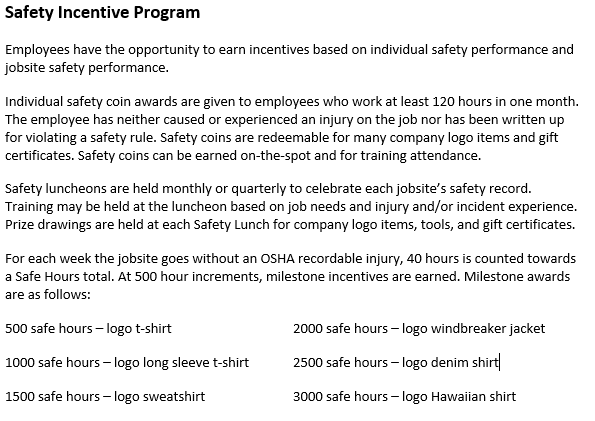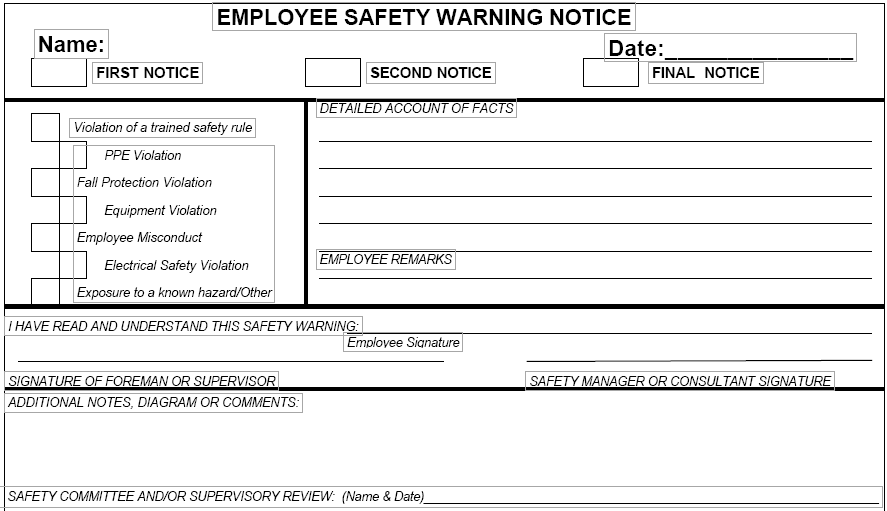Incentive and Enforcement Programs
Words: Mike Adams
Words: Mike Rosser, President, Corporate Safety Services
Photos: Corporate Safety Services
First, let me say that incentive and enforcement programs, or policies, should always be used together. They should complement and reinforce each other.
What is an incentive program?
Incentive programs should reinforce your safety policies and they should heighten employees’ awareness of your safety guidelines and have them top of mind each and every day.
Never initiate an incentive program without a good safety program in place first. If you have a good safety program, everyone knows that you care about them. If you don’t have a good safety program in place and you start an incentive program, employees won’t accept it.
What did OSHA say?
In 2016 OSHA rolled out aggressive guidance that discouraged employers from rewarding employees (with bonuses, pizza parties, or otherwise) for successfully hitting low injury rates. At the time, OSHA reasoned that employees’ mouths would water so much at the idea of a free slice of savory, oily, cheesy pizza that they might withhold information about their own or others’ injuries to keep the rates down and score a tasty meal or other reward.
What does OSHA say now?
Based on guidance issued during the Trump administration, OSHA announced that it was clarifying and effectively rolling back portions of the injury and illness rule it issued in 2016. The decision clarifies and walks back guidance that potentially penalized employers for safety incentive programs. (The Biden administration has not yet addressed these issues.)
The new guidance clarifies the rule further and effectively walks back the most extreme aspect of OSHA’s prior position. Now, OSHA says, “29 C.F.R. § 1904.35(b)(1)(iv) does not prohibit workplace safety incentive programs.” OSHA now recognizes that employers may have such programs in order to promote workplace safety. The agency has now clarified a bit better what is permissible and what isn’t.
OSHA’s newest guidance on safety incentive programs says that:
“Evidence that an employer consistently enforces legitimate work rules (whether an injury or illness has been reported) would demonstrate that the employer is serious about creating a culture of safety, not just the appearance of reducing injury rates.”
Rather than assuming that these programs are improper, OSHA says that it will now issue citations only with evidence of improper intent. A safety incentive program “would only violate 29 C.F.R. 1904.35(b)(1)(iv) if the employer took the action to penalize an employee for reporting a work-related injury or illness rather than for the legitimate purpose of promoting workplace safety and health.”
Rewards for reporting injuries are also okay. Certain programs are always permissible, including those that reward workers for reporting near-misses and hazards and encouraging involvement in the company's safety and health program.
Incentives can be based on injury rates with the right provisions. Rate-based programs that reward employees or supervisors with a prize or bonus for low/no injury rates are permissible as long they “are not implemented in a manner that discourages reporting.” If an employer withholds a prize or bonus because of a reported injury, “OSHA would not cite the employer under 1904.35(b)(1)(iv) as long as the employer has implemented adequate precautions to ensure that employees feel free to report an injury or illness.”
It may not be sufficient to simply make a statement encouraging reporting or prohibiting retaliation. OSHA says that employers using a rate-based incentive program should also implement:
-- Rewards for employees identifying unsafe conditions,
-- Training to reinforce reporting rights and responsibilities, non-retaliation policies, and
-- A way to accurately evaluate employees’ willingness to report injuries and illnesses.
Here’s an example of one company’s program:

Some of our clients have gone to an incentive program based solely on the outcome of our safety audits. Each safety audit report is given a rating, and rewards as follows:
- Great (no safety issues noted)
- Each employee on that project received a $25 grocery store gift card
- Good (minor safety issues noted)
- Each employee received a $10 grocery store gift card
- Needs Improvement (serious or many safety issues noted)
- No gift cards were awarded but a safety meeting is held to discuss the audit and additional training is conducted as needed.
What is an enforcement/disciplinary program?
A disciplinary program for safety violations helps ensure workplace safety and health by letting employees know what is expected of them and providing workers with opportunities to correct their behavior before an incident occurs.
Within a disciplinary program for safety violations, an employer has the exclusive right to administer appropriate disciplinary action, including discharge, to workers for just or proper cause. In most cases, a documented progressive disciplinary approach is required whenever a policy, rule, or safety violation occurs.
A violation is a failure to comply with any company rule or regulation that is not a flagrant or willful disregard for safety. Disciplinary action for this type of violation normally results in a documented verbal warning for the first offense, a written reprimand for the second offense, and a disciplinary suspension or termination of employment for the third offense or other offenses. For a willful violation, the minimum disciplinary action could be a one-day suspension from work without pay. Based on the seriousness of the violation, the action taken in the first or second instance may be more severe.
Everyone should have a clear understanding of your policy. Employees, above all else, need to fully understand the rules and the consequences of breaking those rules. Rules and consequences should be outlined in the company safety manual.
Workers should understand what’s considered a violation. Along with the rules and consequences, violations should be clearly laid out so employees have a reference to turn to if they have any questions. Examples of typical worksite violations include:
a. Drinking alcohol and/or drug abuse prior to or during working hours
b. Fighting, provoking, or engaging in an act of violence against another person at work
c. Theft or willful damage to property
d. Failure to wear required protective equipment (eye protection, safety helmets, etc.)
e. Failure to follow recognized industry practices
f. Major traffic violations while using a company vehicle
The other critical element of workplace discipline programs is proper documentation of disciplinary actions — regardless of the nature of the discipline. Even if the supervisor was able to resolve the issue with a friendly conversation, we must make and file a record of the conversation. That creates a paper trail that can protect the employer’s interests if an employee is terminated because of a record of poor compliance.
Below are several examples of warning notices that can be used:


Summary
- OSHA now believes many employers use safety incentive programs to promote workplace safety and health.
- Enforcing legitimate work rules regarding whether an injury or illness is reported demonstrates that the employer is serious about creating a culture of safety – not simply the appearance of reducing injury and illness rates.
- OSHA particularly favors the type of incentive program that rewards workers for reporting near-misses or hazards and encourages involvement in a safety and health program.
- Train your employees to document all training and enforcement actions. Retain those records.
- Provide all necessary personal protective equipment (PPE) and enforce its use by your employees.
- When employees fail to follow policy, such as not wearing safety glasses or failing to follow other safety rules, then implement graduated accountability.
As always, if you need examples of these programs/policies or have questions, my email is mike@corporatesafetyprograms.com.